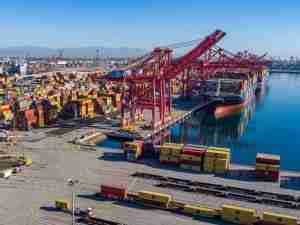Fitch Affirms Jacksonville Port Authority, FL’s Rev Bonds at ‘A’; Outlook Stable
posted by AJOT | Mar 20 2017 at 09:08 AM | Ports & Terminals
Fitch Ratings has affirmed the 'A' rating on the Jacksonville Port Authority, Florida's (JaxPort or the port) approximately $112.4 million in outstanding series 2008 and 2012 revenue and refunding bonds. The Rating Outlook is Stable.
The authority also has $39 million in unrated parity senior loans and $32 million in unrated subordinate loans outstanding.
KEY RATING DRIVERS
Summary: The rating reflects JaxPort's historically stable performance anchored by growing automobile activity in conjunction with sizable contractually guaranteed revenues from existing long-term tenants that limit the port's exposure to operational risk. The rating is further supported by the port's diverse revenue base and desirable location in the Southeast Atlantic, providing greater access to cargo and cruise activities as well as Latin American and Caribbean markets. The port's financial metrics remain healthy, with senior lien debt service coverage ratio (DSCR) expected to remain above 2.0x and senior leverage (excluding interlocal revenues) below 4.0x, consistent with the criteria's indicative rating ranges.
Revenue Risk - Volume: Midrange
Strategically Located Southeastern Port: The port benefits from a desirable location with improving intermodal connectivity and infrastructure that helps maintain its niche importance in the international automobile trade. Nevertheless, JaxPort operates in the highly competitive Southeast Atlantic region for cargo and cruise activities with moderate trade exposure to Latin America and Caribbean markets.
Revenue Risk - Price: Midrange
Diverse Revenue Base with Contracted Tenants: The port's increasingly diverse revenue base has grown at an average rate of 2.8% for the past five years. JaxPort serves as a landlord port with more than half of its operating revenues derived from long-term leases with minimum annual guaranty (MAGs) terms from a diverse group of tenants, including automobile, break-bulk, bulk, and cruise. New services and extended agreements with previous tenants provide revenue protection for the port, though some renewed contracts are shorter, between one to five years.
Infrastructure Development & Renewal: Midrange
Adequate Infrastructure with Development Needs: The port's five-year capital improvement plan (CIP) includes $745 million for a dredging project to make the port accessible to post-Panamax ships. The majority of funding sources are still unspecified and is expected to rely heavily on state grants and operating cash flow, with the possibility of some additional debt. The project is still in the early stages of development and timing of capex remains flexible.
Debt Structure: Stronger
Strong Debt Structure: Senior lien debt is 75% fixed-rate and fully amortizing, with the other 25% consisting of 2009 variable-rate taxable and tax-exempt revenue notes. The variable-rate portion is synthetically fixed, serving to mitigate interest rate and basis risks. The debt service reserve fund (DSRF) is 100% cash-funded and the overall debt service profile is flat to declining.
Stable Financial Profile: The port has seen growing revenues in recent years, leading to senior lien DSCRs averaging over 2.30x, and is expected to remain above 2.0x for the foreseeable future. Liquidity is healthy and has remained above 200 days cash on hand (DCOH) over the last four years. Senior leverage (excluding interlocal revenues) is moderately high compared to peers at 4.72x, but is expected to evolve to below 2.0x by 2021 assuming no additional borrowings. The port also benefits from MAGs in excess of senior debt service requirements and pledged intergovernmental revenue transfers from the city of Jacksonville. Coverage could potentially increase in future years when city debt drops off, increasing the residual interlocal revenues.
PEER GROUP
JaxPort's peers include other 'A' rated Florida ports, including Broward County (Port Everglades) ('A'/ Stable) and Hillsborough County Port District (Tampa Port Authority) ('A'/Positive). Tampa has diverse business operations with contracted revenues similar to JaxPort, while Port Everglades is more reliant on cruise revenues. Port Everglades' coverage is comparable to that of JaxPort and is also expected to remain above 2.0x, while Tampa's coverage is lower averaging 1.63x. Both peers have materially lower leverage (Port Everglades at -0.13x, Tampa at 1.22x) and higher liquidity (Port Everglades with 1,039 DCOH, Tampa with 866 DCOH) than JaxPort.
RATING SENSITIVITIES
Negative: Substantial additional borrowings or a rising expense profile which result in sustained coverage below 1.60x or leverage above 6.0x could lead to a downgrade.
Positive: Positive rating migration is unlikely in the near term given the port's potentially sizeable CIP with unconfirmed sources of funding to date.
Performance Update
Container trade and automobile imports/exports drive the port's cargo trade. Container throughput as measured in 20-foot equivalent units (TEUs) was 968,279 in 2016, up 5.8% from the prior year. Auto shipments handled at JaxPort decreased 1.6% in 2016 as measured in vehicle handles but is still relatively high compared to previous years. Total imports by tonnage were up slightly by 0.5%, while export tonnage dropped 10% mainly due to the strength of the U.S. dollar.
JaxPort's status as a landlord port with long-term contracts and MAGs serves as downside protection to economically sensitive and potentially volatile cargo revenue streams. MAG revenues from throughput guarantees and lease revenues collectively represented 52% of total FY2016 operating revenues. Total operating revenues in FY2016 increased 3.5%, due to growth in auto, container, and break-bulk activities. Four-month YTD 2017 operating revenues before city revenue sharing are down just 1%. The port has historically shown prudent cost management; however, FY2016 operating expenses grew 4.3% primarily due to increases in personnel costs including salaries, and added security. YTD 2017 expenses are down 1%.
JaxPort's five-year preliminary CIP totals $134.6 million, not including the St. John's River deepening project, and is expected to be largely funded by state & federal grants, operating cash flow, and tenant contributions. A number of projects are tentative with unconfirmed sources of funding; however, the port will only initiate projects if funding becomes available. The port is planning to take part in a harbor-deepening project to remain competitive in light of the Panama Canal expansion and larger post-Panamax ships. The project is sizeable at an estimated $745 million, and management expects to attain the majority of funding through state & federal grants, but may potentially issue new debt if deemed necessary. Management has prioritized maintaining its current credit rating and has noted that should they require new debt, they would not issue amounts that would lead to a downgrade.
Metrics for 2016 continued to improve and exceeded previous base case expectations, with senior DSCR growing to 2.56x (2.27x in 2015), and consolidated DSCR increasing to 1.69x (1.64x in 2015). Leverage on the senior lien continued to devolve, down to 4.25x without the use of interlocal revenues.
Fitch Cases
Fitch's base case assumed the sponsor's fiscal 2017 budget, followed by revenues growing or declining at five-year historical compound annual growth rates (CAGRs) from 2018 onward, with slightly less growth forecast for automobile revenues to reflect capacity constraints. Expenses grow at 3.0% per year. This scenario produced a senior DSCR averaging 2.67x (2.05x all-in) with a minimum of 2.25x (1.46x all-in). Senior leverage (excluding interlocal revenues) is expected to drop to 1.89x by 2021.
Fitch's rating case also assumed the sponsor's fiscal 2017 budget, and stressed automobile and container revenues in 2018 and 2019. All other revenues are held flat or decline at historical CAGRs. Expenses grow 4.0% in 2018 and 2019, and escalate to 4.5% growth thereafter. This scenario produced a senior DSCR averaging 2.24x (1.70x all-in) with a minimum of 1.72x (1.28x all-in). Senior leverage (excluding interlocal revenues) is expected to drop to 3.52x by 2021.










